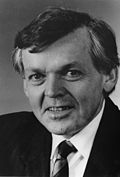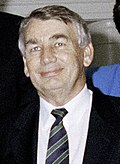Fourth Hawke ministry | |
|---|---|
| 57th Ministry of Australia | |
Bob Hawke Paul Keating | |
| Date formed | 4 April 1990 |
| Date dissolved | 20 December 1991 |
| People and organisations | |
| Monarch | Elizabeth II |
| Governor-General | Bill Hayden |
| Prime Minister | Bob Hawke |
| Deputy Prime Minister | Paul Keating Brian Howe |
| No. of ministers | 31 (plus 4 Parliamentary Secretaries) |
| Member party | Labor |
| Status in legislature | Majority government |
| Opposition party | Liberal–National coalition |
| Opposition leader | John Hewson |
| History | |
| Election | 24 March 1990 |
| Legislature term | 36th |
| Predecessor | Third Hawke ministry |
| Successor | First Keating ministry |
| ||
|---|---|---|
Member for Wills (1980–1992)
Term of government (1983–1991)
Ministries Elections | ||
The fourth Hawke ministry (Labor) was the 57th ministry of the Government of Australia. It was led by the country's 23rd prime minister, Bob Hawke. The fourth Hawke ministry succeeded the third Hawke ministry, which dissolved on 4 April 1990 following the federal election that took place on 24 March. The ministry was replaced by the first Keating ministry on 20 December 1991 following the resignation of Hawke as prime minister after a successful leadership challenge by Paul Keating. [1]



























